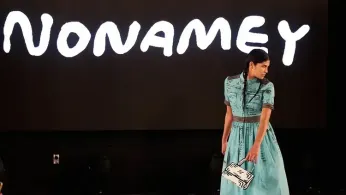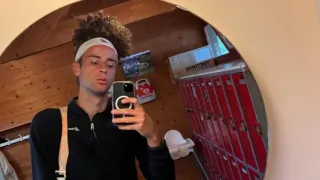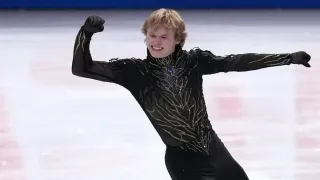
Nov 15
Two-Spirit Threads: Nonamey’s Anti-Colonial Couture Reframes Indigenous and Queer Identity
READ TIME: 3 MIN.
On a luminous runway in Santa Fe, the air pulsed with anticipation as models adorned in bold, transformative pieces took their first steps, each garment a testament to survival, memory, and revolution. At the center of this movement was Nonamey—a Two-Spirit Anishinaabe artist whose work at Native Fashion Week 2025 has become emblematic of a shifting paradigm in both Indigenous and LGBTQ+ fashion culture .
Nonamey’s latest collection, described as “a love letter to my ancestors, my community, and all the stories stitched into who I am as a Two-Spirit Anishinaabe artist,” reinterprets colonial silhouettes through an Indigenous lens. Each piece tells a story of reclamation, resilience, and radical joy, offering a new template for what queer Indigenous fashion can be .
The core of Nonamey’s style is rooted in what they call “anti-colonial aesthetics.” This manifests in garments that borrow from colonial-era pieces—such as tailored coats, corsets, and structured dresses—but subvert their meaning through Indigenous materials, beadwork, and symbolism. Garments are frequently hand-embroidered or pieced together from upcycled textiles, inverting the narrative of scarcity into one of abundance and beauty .
Nonamey’s influences are manifold. They channel their Anishinaabe heritage, referencing traditional regalia, ribbonwork, and family histories of survival. Their work is also informed by the lived experience of being Two-Spirit—a term used in many Indigenous communities to describe a person who embodies both masculine and feminine spirits, often holding special roles as healers, mediators, and knowledge keepers . The collection’s silhouettes echo both powwow finery and the rebellious spirit of queer clubwear, producing a visual language that is distinct, defiant, and deeply personal.
Their runway shows are not just about fashion; they are acts of performance art and protest. In 2025, Nonamey’s models walked with red handprints painted across their faces and bodies, referencing the ongoing crisis of missing and murdered Indigenous women, girls, and Two-Spirit people. This was paired with beadwork and appliqué that invoked stories of family, ceremony, and resistance to erasure .
Nonamey’s impact reaches far beyond the runway. Their approach is deeply collaborative, frequently working with other queer and Two-Spirit artists, beaders, and photographers to create not just clothing, but a living archive of Indigenous queer experience. At Native Fashion Week, their backstage team included young trans and Two-Spirit models, many walking a major runway for the first time, who described the experience as “life-changing” and “affirming” .
In interviews, Nonamey has emphasized the necessity of Indigenous and LGBTQ+ self-representation in fashion, noting that “taking the scraps that been given throughout history, transforming them into something beautiful and sacred” is central to their process . This philosophy resonates with the broader movement at Native Fashion Week, where designers like Korina Emmerich and Darcy Big Horse also foreground Indigenous and queer storytelling through their collections .
Nonamey’s presence at events such as Native Fashion Week marks a significant shift in the fashion landscape. For many years, Indigenous and queer designers were often marginalized, their work appropriated or erased by the mainstream. Now, with platforms like Native Fashion Week and Vancouver Indigenous Fashion Week providing dedicated space, designers like Nonamey are not only reclaiming their narratives but are also actively shaping the future of the industry .
The rise of Nonamey and their peers reflects a larger global movement in which Indigenous, Two-Spirit, and trans designers are asserting their identities and histories through fashion. Events such as Native Fashion Week in Santa Fe, Indigenous New York Fashion Week, and Vancouver Indigenous Fashion Week have become focal points for community-building, activism, and artistry .
At Native Fashion Week 2025, the urgency of political and cultural messages was palpable. Designers used color, motif, and performance to address issues such as cultural appropriation, systemic marginalization, and attacks on queer and trans rights. For example, collections incorporated the red, green, and black of the Palestinian flag to call for international solidarity, and light shows protested political threats to bodily autonomy and Indigenous sovereignty .
This intersection of fashion, activism, and identity is especially meaningful for rural and remote queer and trans creatives, who often face additional barriers to visibility and support. By foregrounding Two-Spirit and trans voices, designers like Nonamey are providing not only inspiration but also a sense of belonging and hope for LGBTQ+ youth across Turtle Island and beyond .
The momentum generated by Nonamey and the broader movement of queer Indigenous fashion is unlikely to wane. With continued support from events like Native Fashion Week and a growing network of collaborators, Two-Spirit and trans designers are poised to further shape both the aesthetics and the politics of contemporary fashion .
As Nonamey’s collection so powerfully demonstrates, fashion is not merely about clothing—it is about story, survival, and the right to be seen. In every bead, stitch, and silhouette, there is a declaration: queer Indigenous futures are vibrant, expansive, and unstoppable.






